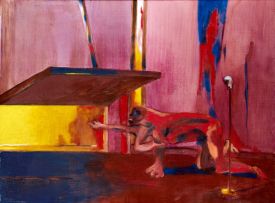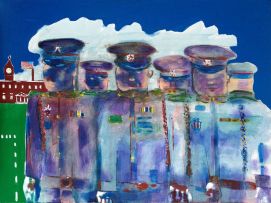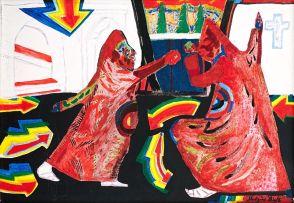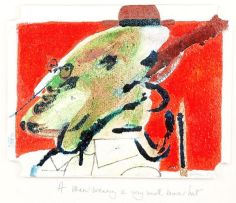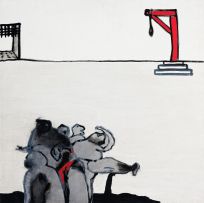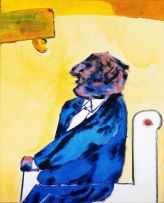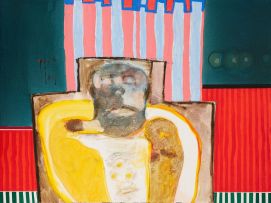Important South African & International Art, Jewellery and Decorative Arts
Live Auction, 12 October 2015
Important South African and International Art, Evening Sale
Incl. Buyer's Premium & VAT
About this Item
signed, dated 1994, inscribed with the medium, the title and 'BEGUN LATE JANUARY 1994' on the reverse
Notes
Endgame is the name given to many a play, film, book title, band or album, game, technological process and even military strategy, but none would have been more significant to Robert Hodgins than Samuel Beckett's one-act play first performed in 1957 and commonly considered, along with such works as Waiting for Godot, to be among Beckett's most important works. The English title is taken from the last part of a chess game, when there are very few pieces left.
Hodgins' End Game echoes one of the artist's most powerful and best-known paintings, A Beast Slouches, held in the permanent collection of Wits Art Museum. Painted in 1986, it is described in Hodgins' monograph by then Senior Curator of the University of the Witwatersrand Art Galleries, Rayda Becker, as 'an icon of the social distortions of South Africa in the 1980s'.1 She describes the crouching, slouching figure as an echo of William Blake's Nebuchadnezzar with its art historical precedents in Goya and Bacon. Its title is drawn from the following stanza in WB Yeats' The Second Coming:
And what rough beast, its hour come round at last,
Slouches towards Bethlehem to be born?
Intuiting some beast coming to wreak untold havoc on the world, the poem presages the despair caused by World War I. Hodgins was clearly inspired by Yeats' iconography:
A shape with lion body and the head of a man,
A gaze blank and pitiless as the sun,
Is moving its slow thighs …
Painted in 1994, End Game prefigures both the massive upheavals of South Africa's first democratic election and the prospects of the new millennium. In a confined space with red, flayed walls, a strange beast crawls past an onstage microphone towards a trapdoor opening onto a vista which may be read as aglow with bright sunshine or ablaze with fire and billowing smoke.
It remains one of his most iconic images, as prescient as the most famous words from Yeats' poem:
Things fall apart; the centre cannot hold;
Mere anarchy is loosed upon the world,
The blood-dimmed tide is loosed, and everywhere
The ceremony of innocence is drowned;
The best lack all conviction, while the worst
Are full of passionate intensity.
1. Rayda Becker. (2002) 'Made in Africa?' in Robert Hodgins, Cape Town: Tafelberg. Page 39, illustrated in colour on pages 40-41.

